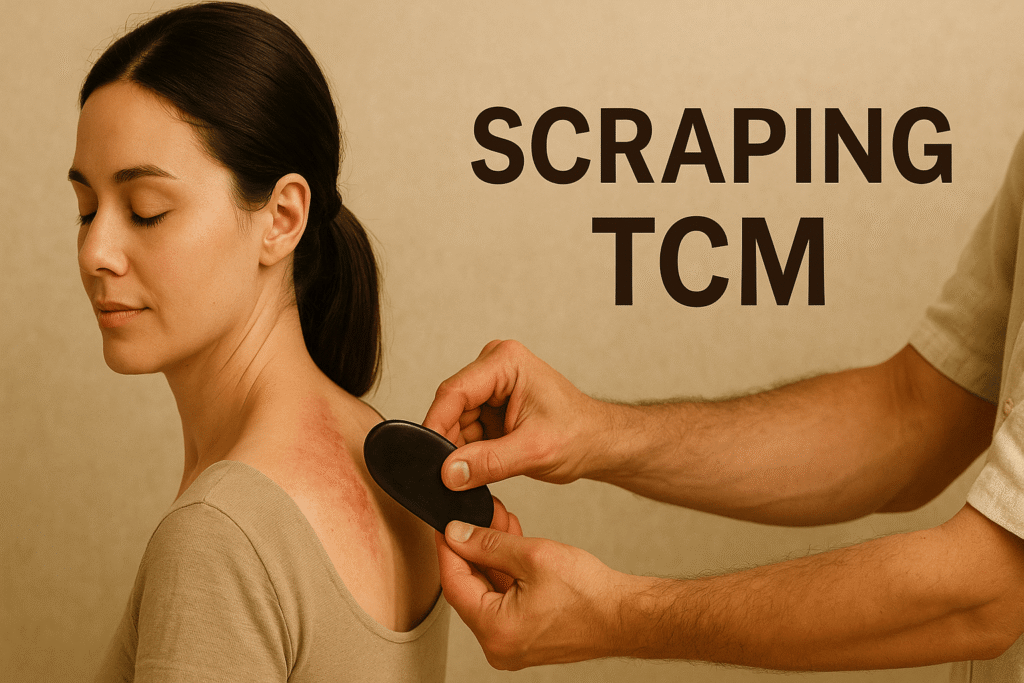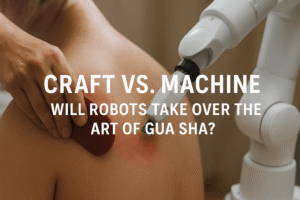
Scraping TCM, better known as “gua sha,” is a miraculous Traditional Chinese Medicine practice with a history stretching back thousands of years. Today, with the increasing interest in natural therapies, it’s gradually spreading from the East to become a daily choice for people in many Western countries seeking natural health.
What is Scraping TCM & Why is It so Popular?
“Scraping TCM” is a traditional Chinese medicine (TCM) treatment, and alongside acupuncture, it constitutes an important Qi and blood therapy method. It works by rubbing a scraping tool across the body’s surface, using friction and pressure to relax muscles and activate joints, balancing Qi and blood.
For thousands of years, gua sha was a folk remedy practiced in China and other Asian countries. It was popular among the working class, but less so among the upper classes due to its low cost and ease of use. Its current surge in popularity is primarily due to a combination of market demand and social media promotion.
The growing demand for natural beauty and wellness coincides with the non-invasive nature of scraping. This has opened up a wide potential customer base.
With the growth of social media, which has gradually surpassed traditional search platforms, numerous beauty and health bloggers have begun sharing videos of their experiences using gua sha on mainstream media platforms like YouTube and TikTok, rapidly spreading the practice globally.
Theoretical Basis of Traditional Chinese Medicine for Scraping TCM
In Traditional Chinese Medicine, “sha” (Gua Sha) is a manifestation of internal stagnation and the accumulation of harmful qi. It’s like a city’s drainage system: excessive garbage congestion in one area prevents proper drainage, creating a blockage that impacts the entire system. Scraping TCM is like a cleaning tool, physically breaking up and removing stagnant harmful qi and other harmful substances, thereby unblocking the body’s entire “drainage system.”
Gua Sha is miraculously effective in treating headaches, colds, and muscle aches caused by wind and cold, often with immediate relief.
P.S.: While certain experiments and user experiences have confirmed its effectiveness, and it’s considered a low-risk treatment, the theory behind Gua Sha is still lacking sufficient clinical or research data. Therefore, we recommend consulting a professional doctor for Gua Sha advice based on your individual situation.
Gua Sha Tools and Body Part Selection
Gua Sha tools have become increasingly diverse over time. In China, buffalo horn tools are widely accepted. Outside of China, jade and other materials are more accepted, while metals like stainless steel are rapidly gaining popularity. With the exception of materials like plastic that may contain harmful substances, the choice of material is entirely based on personal preference and needs.
Common areas for Gua Sha treatment include the back, shoulders, neck, arms, legs, and forehead. In modern cosmetic Gua Sha, the face plays a crucial role. Choosing the right area for Gua Sha depends on your specific symptoms.
Scraping TCM Benefits
Gua Sha has rapidly gained global popularity not only because of its affordability and convenience, but also because of its practical and effective benefits. Gua Sha offers comprehensive treatment options for a wide range of people, including:
- Relieving muscle tension and promoting recovery from sports injuries.
- Boosting blood circulation and improving the balance of Qi and blood.
- Boosting immunity and increasing resistance to disease.
- Beauty-enhancing, promoting skin repair, and improving skin condition.
Modern Research and International Acceptance
In recent years, a growing number of international studies have focused on the therapeutic effects of Gua Sha. For example, a study published in The Journal of Pain [1] demonstrated its significant effectiveness in relieving chronic neck pain. Countries like Germany, the United States, and Australia have incorporated Gua Sha into the fields of naturopathy and integrative medicine.
- Article Title: Effectiveness of Traditional Chinese “Gua Sha” Therapy in Patients with Chronic Neck Pain: A Randomized Controlled Trial
- Publication: Pain Medicine, Volume 12, Issue 3, March 2011, Pages 362–369
- Study Location: University Hospital Duisburg-Essen, Germany
- Study Design: Forty-eight patients with chronic mechanical neck pain were randomly assigned to either a Gua Sha group or a control group (hot compress). Each group received a single treatment and were evaluated one week later.
- Results: The Gua Sha group showed significantly greater improvement in neck pain on the Visual Analog Scale (VAS) compared with the control group (between-group difference -29.9 mm, 95% CI -43.3 to -16.6 mm, P < 0.001). Significant improvements were also observed in measures of pain with movement, the Neck Disability Index (NDI), and quality of life. The treatment was safe and well-tolerated.
Especially amidst the growing global interest in non-drug therapies and sustainable health approaches, Gua Sha, a traditional Chinese medicine practice, has become a representative Eastern wisdom.
Conclusion
Gua Sha, a traditional Chinese medicine (TCM) natural therapy spanning millennia, is experiencing a resurgence with a modern, international perspective. From ancient herbal decoctions and acupuncture to today’s “Scraping TCM,” we witness not only the inheritance of technology but also the continuation of a philosophy: harmonious coexistence between man and nature, self-healing, and inner awareness.
Among the myriad health care options, Gua Sha may not be the fastest shortcut, but it may be one of the most balanced and fundamental paths.






